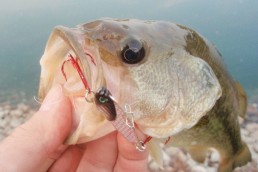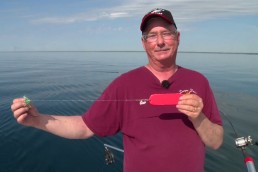Blade Baits are Predator Producers in the Spring
SHARE THIS POST
Not too long ago I hiked a short distance from my house to a small pond where I caught a few largemouths on a vibrating blade bait. When a friend came by and looked at my lure, he remarked that he’d never seen one like it. That came as no surprise to me. Even though blade baits have been in existence for decades, many remain unfamiliar with this dandy little bait.
This unfamiliarity is one of the ingredients that make this hard-metal lure so appealing to a variety of freshwater species. I’m a firm believer that predatory species like largemouths, walleyes, smallmouths and pike can become conditioned to certain offerings they see on a regular basis. Don’t ask me for a biological explanation; I just know from my research on the water and reports from others. When I show fish something they may not have seen before, my odds for success increase.
Blade baits are marketed under a variety of names such as Worden’s Showdown, VIB“E” and Heddon’s Sonar, Reef Runner Cicada and Bass Pro Shops’ XPS Lazer Blade. All share certain features and are metallic, weight-forward, and when retrieved, all vibrate.
You want a lure that has a shape that mimics a shad or some other food fish. Also, you want its body to resemble a predator’s natural prey. Some have a holographic finish that emits a great deal of flash during a retrieve that attracts lurking predators.
One drawback to some blade baits is that the lures can lose a hooked fish. Not so with some, like the Lazer Blade, since its hooks are fastened to a strong split ring and does not afford fish any leverage to throw the hook when it jumps or wallows on the surface.
Are you enjoying this post?
You can be among the first to get the latest info on where to go, what to use and how to use it!
A novice to blade bait fishing will find that there is nothing simpler; you merely cast it and wind it back to the boat or the bank. The weight of the metal body of one will cause it to sink quickly, so if you are fishing over emergent weed beds or over beds of grass, just keep your rod tip up during the retrieve. The natural action of the lure will cause it to continuously wobble. In clear ponds or lakes, try a pumping retrieve, reel fast for a few turns, then stop and let it sink for a second or two, then return to a fast retrieve.
You may even want to use these versatile lures as a “waking” bait by engaging your reel the moment the lure hits the water. This keeps your rod tip very high and reeling very fast creates a vibrating bulge just under the water’s surface. This kind of action can drive bass wild, resulting in savage strikes.
Anglers at Indian Lake have had success catching saugeyes by jigging blade baits near any bridge or at the mouths of the many channels. I have done the same and have had luck with lures at 1/4 to 1/2 ounce. Catching a few now and then only further reinforces my belief that fish will be attracted to something they may never have seen before or have not in a long time.
This spring, when the shad are on the move or when any species of baitfish travels along the natural contours of a lake or pond bottom and big fish are following, break out a few blade baits and get in on some great angling action.
MWO
SHARE THIS POST
Did you enjoy this post?
You can be among the first to get the latest info on where to go, what to use and how to use it!
John Bennett
John Bennett is a retired history teacher, historical re-enactor, father and grandfather. As a four-season outdoorsman, his passion is waterfowl hunting and fishing for smallmouth bass. He lives in Ohio and spends quite a bit of time in his primitive log cabin, which he built.



